A well-designed concrete front yard is durable, stylish, and low-maintenance. It instantly boosts your home’s curb appeal.
In 2025, landscaping trends focus on sustainability, function, and modern minimalism. Concrete is no longer just a plain gray slab.
It has become a true canvas for creativity. You can choose front yard pavers, stamped finishes, or sleek modern slabs.
This guide covers it all—design inspiration, cost, care, and common mistakes to avoid.
Table of Contents
Why Choose a Concrete Front Yard?
Concrete has become a go-to choice for homeowners because it balances affordability with flexibility in design. Unlike traditional lawns, a paved front yard requires less water, resists erosion, and offers versatile layout options.
Benefits
- Durability: With proper sealing and care, concrete surfaces last decades.
- Customization: Options include stamped textures, exposed aggregates, and colored finishes.
- Modern aesthetics: The modern concrete front yard trend emphasizes clean lines, neutral palettes, and minimalist layouts.
Curb appeal studies also show that thoughtful hardscaping can significantly increase property value—an important factor if resale is in your future.
Front Yard Pavers – The Foundation of Style
Pavers are the backbone of many front yard concrete ideas, offering both function and style.
- Types of pavers: Concrete, stone, and permeable interlocking concrete pavement (PICP).
- Pattern variety: Herringbone, basket weave, grid layouts, or irregular natural looks.
- Sustainability: Permeable pavers allow rainwater to soak into the ground, reducing runoff and supporting eco-friendly landscaping.
A paved front yard doesn’t have to feel industrial; pairing pavers with greenery softens the look and creates balance.
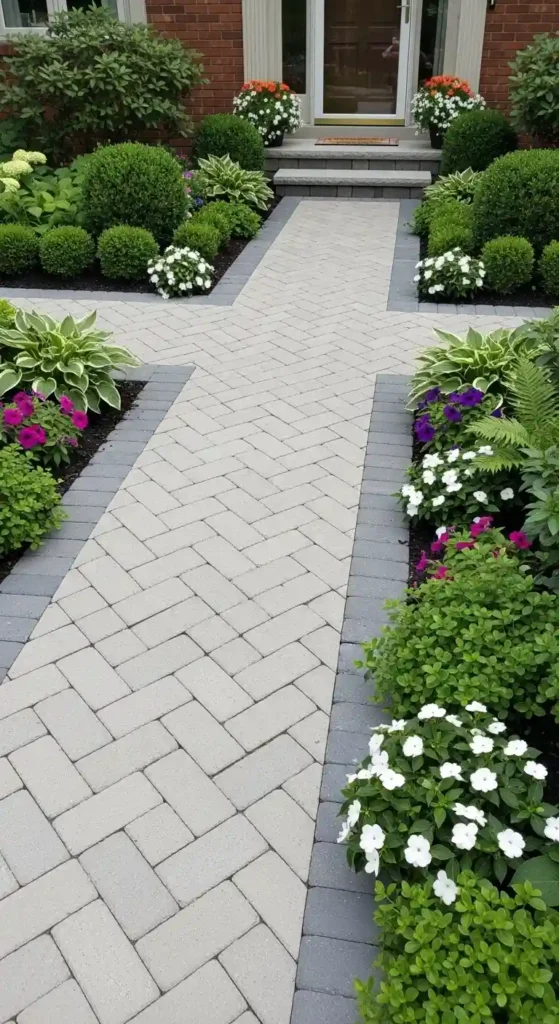
Front Yard Landscaping Ideas with Pavers
Concrete pavers aren’t just for driveways—they shape pathways, seating areas, and integrated landscape features.
Popular Uses
- Walkways & paths – Large concrete slabs separated by gravel or turf strips add rhythm and guide guests to the entryway.
- Driveways – Ribbon-style drives (two parallel strips of concrete with grass in between) are stylish and eco-conscious.
- Seating areas – A small paver patio near the entry adds functionality, ideal for planters or benches.
Mixing front yard ideas with pavers into planting beds creates contrast, especially with ornamental grasses, succulents, or colorful perennials.
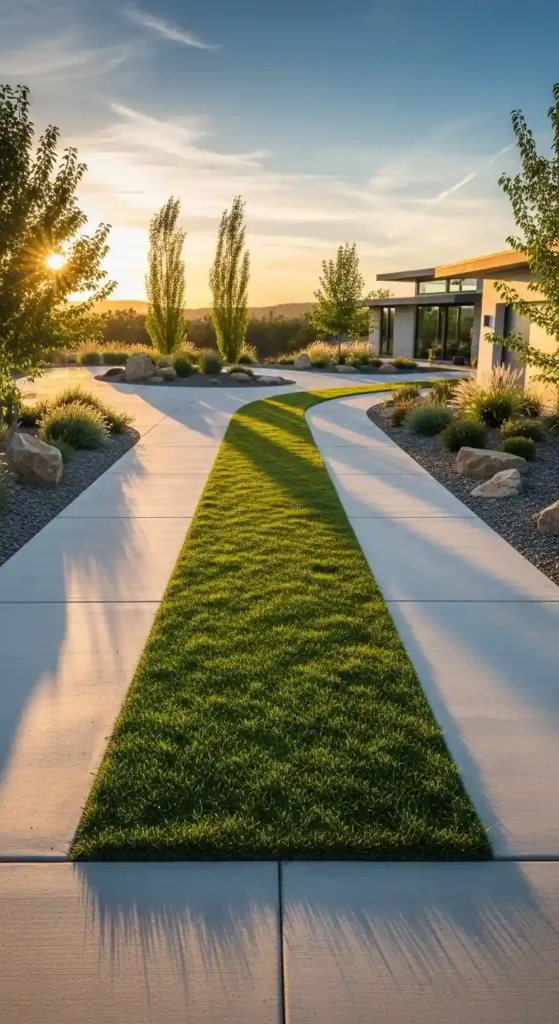
Front Yard Concrete Landscaping Ideas
Concrete goes beyond utility—it can be a true design element.
- Exposed aggregate finishes: Show off embedded stones, adding texture and slip resistance.
- Stamped concrete: Mimics natural stone, slate, or even wood planks.
- Board-formed concrete: Popular in modern concrete front yard projects, creating a natural wood-grain effect.
When paired with contemporary plantings and lighting, these front yard concrete designs can feel warm, inviting, and highly personalized.
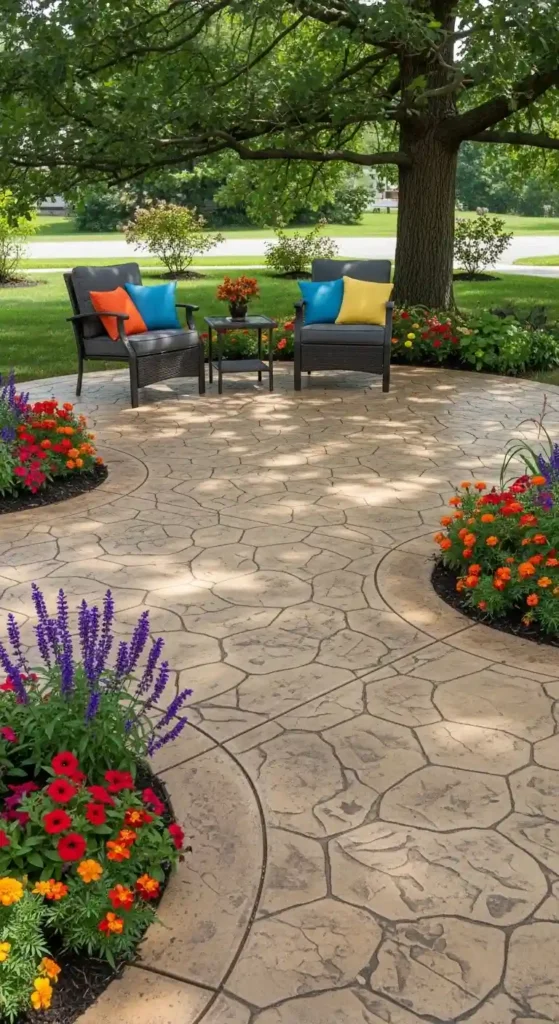
Modern Concrete Front Yard Styles
Minimalism and functionality dominate 2025 landscape trends.
- Clean lines & geometry: Large-format slabs with narrow gaps filled by gravel or groundcover.
- Neutral color palettes: Shades of gray, beige, or cream serve as backdrops for bold accents like planters or sculptural plants.
- Sustainable planting: Xeriscaping (low-water landscapes) paired with concrete hardscapes keeps maintenance low.
- Lighting integration: LED path lighting, step lights, or under-slab glow strips add nighttime appeal.
These front yard cement ideas balance aesthetic appeal with long-term practicality.
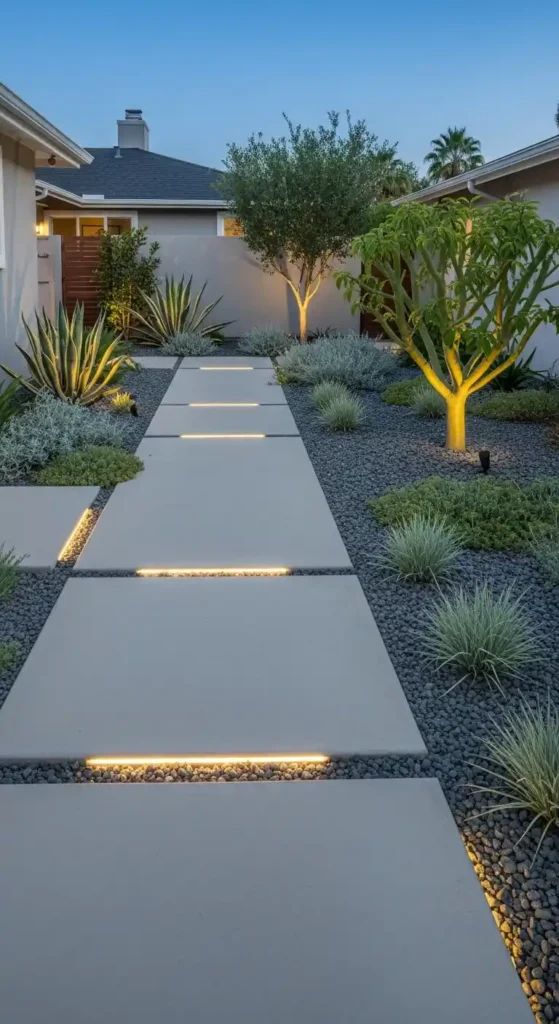
Functional & Sustainable Design Tips
A concrete front yard can be both eco-friendly and functional if designed thoughtfully.
- Drainage & permeability: Consider pervious concrete or PICP to reduce runoff.
- Cool pavements: Light-colored slabs reflect heat, reducing the urban heat island effect.
- Accessibility: For walkways, follow ADA-inspired slopes (≤1:20) and use textured finishes for safety.
- Rain gardens: Channel runoff from paved areas into landscaped swales filled with native plants.
This approach enhances curb appeal while addressing climate concerns.

Budgeting & Cost Considerations
Costs vary depending on materials, design complexity, and region:
- Basic concrete slabs: $5–$10 per sq. ft.
- Stamped or decorative finishes: $12–$20 per sq. ft.
- Pavers (concrete or stone): $15–$25 per sq. ft. installed.
- Pervious concrete or PICP: Slightly higher, but offset by reduced drainage infrastructure.
While upfront costs may seem higher than traditional lawns, long-term savings from reduced water use and minimal maintenance make a front yard concrete design a smart investment.
Maintenance & Care Guide
Concrete and pavers require upkeep to preserve their look and safety.
- Sealers: Penetrating sealers protect against stains and water damage; matte vs gloss affects aesthetics and slip resistance.
- Winter care: Avoid harsh de-icing salts in the first year; use calcium chloride-based products sparingly afterward.
- Cleaning: Power wash annually and reseal every 3–5 years.
Maintained properly, a front yard paver or concrete landscape can look new for decades.
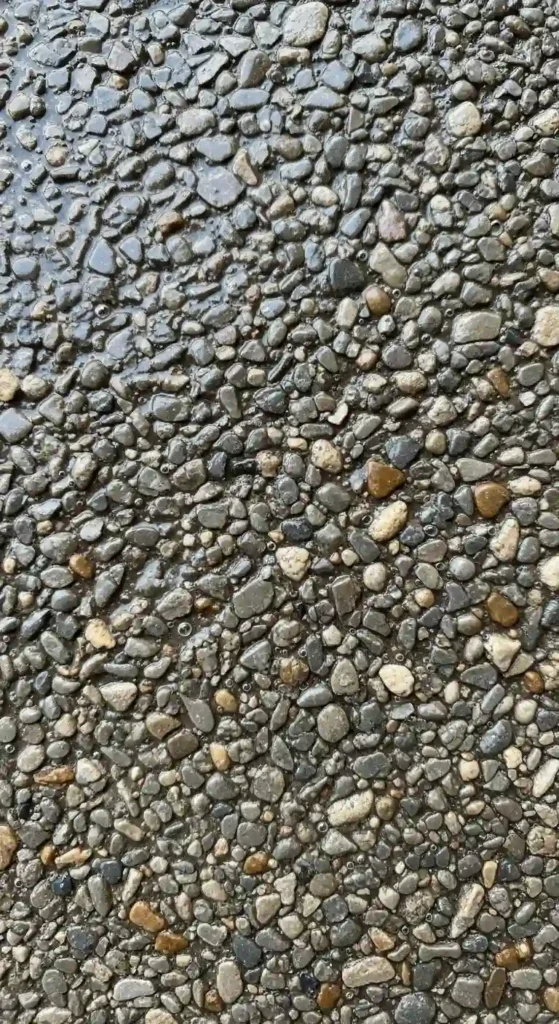
Mistakes to Avoid in Concrete & Paver Yards
- Skipping control joints: Leads to unsightly cracks.
- Using glossy sealers on slopes: Increases slip hazards.
- Over-paving without permeability: Can cause drainage problems and even legal issues in some jurisdictions.
- Neglecting slope: Improper grading leads to pooling and frost damage.
Avoiding these mistakes ensures a long-lasting and safe yard design.
Final Thoughts
A concrete front yard doesn’t need to be boring. From front yard pavers to modern concrete designs, the right layout can transform your outdoor space into a stylish, functional, and sustainable asset.
By balancing inspiration with practical guidance—covering cost, maintenance, and sustainability—you’ll create a yard that’s both beautiful today and resilient for decades to come.
FAQ’s
Is concrete or pavers better for a front yard?
Pavers offer repair flexibility and design variety, while concrete slabs are more affordable upfront.
Do I need permission to pave my front yard?
In some regions (like the UK), impermeable paving over 5m² may require planning permission. Permeable solutions avoid this issue.
How long does a concrete front yard last?
With proper installation and maintenance, 25–40 years is common.
Can I mix grass and concrete for a modern look?
Yes—ribbon driveways and turf gaps between slabs are trending eco-friendly solutions.
